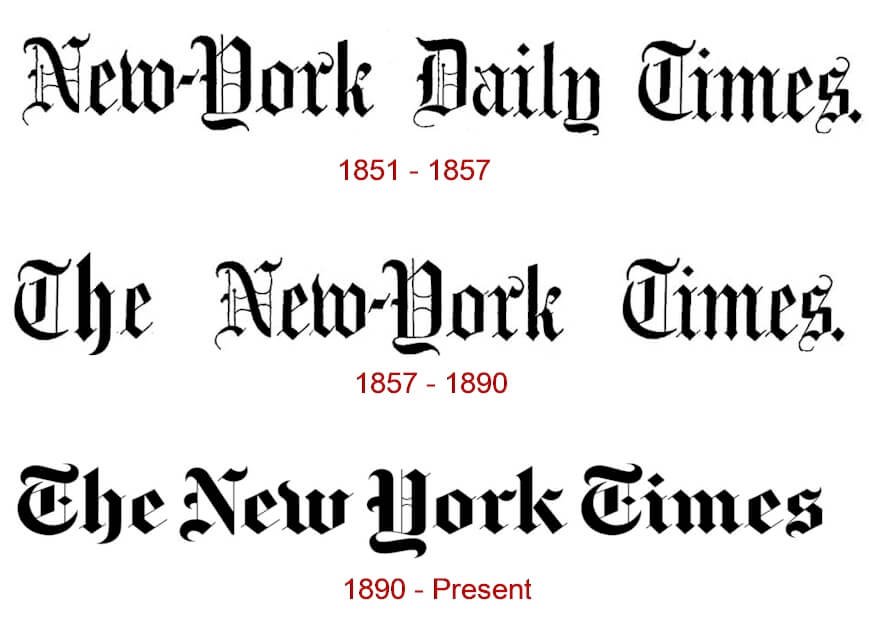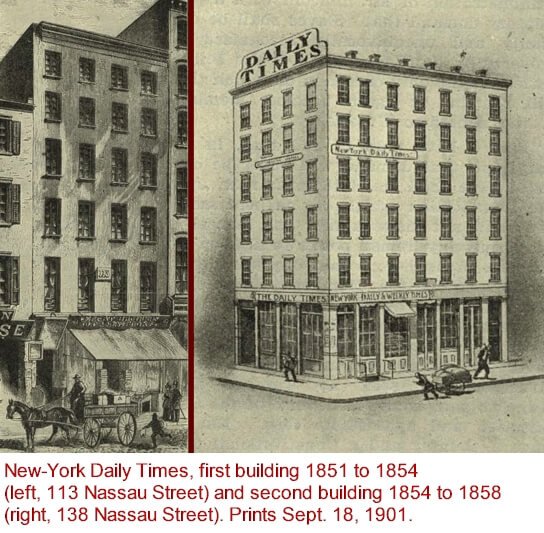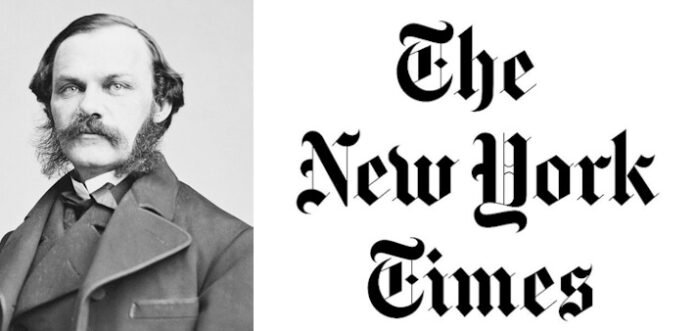The New York Times Logo and the History of the Newspaper
The New York Times (aka The Times, NYT, or NY Times) has a unique logo that has looked almost the same since the newspaper was founded in 1851. While the logotype has been altered a number of times, it has never been radically changed. Therefore, it’s safe to say that The New York Times is a timeless newspaper.
The current New York Times symbol is widely regarded as one of the best and most powerful logotypes of all time. The NYT logo was designed in the late 1960s by renowned U.S. typographer Edward Benguiat, who also created logos for magazines such as Sports Illustrated, Playboy, and Esquire. In the 1980s, the newspaper’s logo was redesigned by font designer John Parkinson.
The New York Times logo symbolizes the long and illustrious history of the newspaper. Its black and white color scheme matches the entire newspaper’s headings, giving the paper its original look and style. The color scheme also makes the newspaper look classic and timeless.
The Times logo has existed for the better part of two centuries. It holds plenty of history about the classic newspaper. Whenever you’re reading the paper, it’s good to appreciate its logo, for it has traveled an incredible journey together with the paper throughout the years.
The New York Times Logo History and Evolution

The New York Times emblem has been altered rarely and just slightly, but loyal readers have spotted even the slightest of changes. For instance, at one time, the hyphen from the city’s name and the full stop after “Times” was removed, which reportedly caused over 1,000 subscribers to ditch the newspaper.
1851 — 1857
In the year 1851, The New York Times published its first issue. Back then, it went by the name The New York Daily Times.
1857 — 1894
In 1857, The New York Daily Times was rebranded The New York Times, aptly reflecting the name change in the logo. The word “Daily” was dropped, and the article “The” was added. The designers made another major alteration in1884 when they added curls at the end of letters “R,” “N,” “S.”
1894 — Present

In 1894, the logotype again became restrained, with both letters “T” being adorned with an arrowhead decoration. Two years later, the hyphen was removed from both the newspaper’s logo and official name.
This was a gross violation of grammatical rules that was roundly criticized. It wasn’t until the December 30th, 1914 issue that the typography was altered—it had the hind leg of the “h” shortened.
In early 1967, typographer Edward Benguiat was tasked with redesigning the logotype. He decided against changing the original style to keep the logo recognizable. Instead, he tweaked the shape of the letters a little, removed the arrow inside the letter T, and replaced it with a diamond.
The logo was subsequently redesigned by other designers a number of times, but the front page heading was still rendered in a font created by Edward Benguiat.
The New York Times Logo Design Elements

Font: The current New York Times emblem was designed by Edward Benguiat, a renowned American typographer who also authored several fonts (including Korinna, Tiffany, Souvenir) and designed logos for magazines such as Sports Illustrated, Esquire, and Reader’s Digest. The logo appears to be based on a classic black letter font, but it’s actually hand-made.
Color: The logo makes use of a black and white color palette. The rest of the newspaper’s headlines also use the same color scheme. It looks classic and emphasizes each letter’s elaborate shape. The black in the logo represents the excellence, strength, elegance, innovation, and dynamic outlook of the newspaper.
The History of New York Times
Published in New York, The New York Times (aka The Times) is distributed internationally. The New York Times Company owns the newspaper as well as 15 other papers, including The Boston Globe and The International Herald Tribune.
The New York Times became the biggest metropolitan newspaper in America, and the famous Times Square is named after it. Due to its staid style and appearance, it’s also known as the “Gray Lady,” and the name of the paper is sometimes shortened to “The Times”—however, it shouldn’t be mistaken for the famous British newspaper The Times.
The Times is a highly influential newspaper both in America and the world at large, even though it’s not the highest-circulating paper. It has won nearly 100 Pulitzer Prizes, delivering consistently incisive and high-standard editorials, along with a broad and detailed coverage of American and international news. Since 1995, its website has also grown to become one of the leading online news sites for readers worldwide.
Origins

In 1851, ex-banker George Jones and journalist-turned-politician Henry J. Raymond founded the New York Daily Times, which The New York Times Company first published. Original investors in the newspaper included Christopher Morgan, Edward B. Wesley, and Edwin B. Morgan.
First sold for the equivalent of $0.30 as of 2020, the first edition tried to address several speculations about its purpose and viewpoints that preceded its publication.
In 1852, The Times launched a western division named The Times of California. This publication came out each time a mail boat arrived in California from New York. However, the venture ultimately proved unsuccessful once local California papers gained more prominence.
In 1857, The New York Daily Times officially rebranded The New York Times, and the hyphen in the name of the city was later dropped altogether in 1896. In 1861, The Times started publishing a Sunday publication to offer daily news of the American Civil War.
Henry Raymond died in 1869, and George Jones replaced him as publisher. The newspaper grew in influence between 1870 and 1871 by publishing several misdeeds committed by William Tweed, New York’s leader of the Democratic Party. This led to the end of the domination of the City Hall by Tweed’s political allies. Tweed had tried to bribe The Times with $5 million dollars (about $108 million dollars as of 2020) to kill the story.
The Times gradually stopped backing Republican Party candidates in the 1880s and became more analytical and politically neutral. In 1884, the newspaper-backed Democratic Party presidential candidate (former New York Governor and Buffalo Mayor) Grover Cleveland in his first stab at the presidency. While this decision cost the paper some of its readership, especially Republican supporters, the newspaper eventually recovered most of its readership in a few years.
The famous Times Square was named after The New York Times in 1904 after the newspaper moved to a new head office on 42nd Street, Longacre square. This was where The New York Times started the New Year’s Eve ritual of lowering a lit sphere from the Times Square building in 1907.
After just nine years at Times Square, the newspaper relocated to 43rd Street 229 West in 1913. The paper’s current headquarters is a skyscraper named the New York Times Tower, which was opened at Manhattan’s 620 8th Avenue in 2007. The New York Times had sold the first Times Square building in 1961.
In 1904, a naval battle gave The New York Times its first-ever on-the-spot wireless transmission, a story about the obliteration of the Soviet Union fleet in Yellow Sea’s Battle of Port Arthur during the Russia-Japan War.
In 1919, the newspaper was delivered for the first time to London, UK. In 1910, The Times started being delivered to Philadelphia by air. In 1920, a “4-o’clock-in-the-morning Airplane Publication” was delivered to Chicago by air so that Republican Convention delegates could receive it by evening.
During the Second World War, two New York Times reporters, Japan-based Otto D. Tolischus and North-Africa-based Harold Denny, were held hostage as prisoners of World War 2. Tolischus was accused of espionage and tortured. Both were ultimately released.
In 1942, The Times started to feature a crossword puzzle and also acquired the radio station WQRX, renowned for classical music. The paper launched the fashion segment in 1946. The newspaper also launched an international publication the same year but stopped its publication in 1967, instead teaming up with The Washington Post and The New York Herald Tribune to introduce The International Herald Tribune. The Times became the sole publisher of The International Herald Tribune in 2003.
In 1945, a science reporter named William L. Laurence was recruited by the U.S. government to author the formal history of the 1945 atomic bomb project. On the operation to bomb Nagasaki, he was the sole journalist on the plane.
The Op-Ed’s segment began appearing in 1970. The Times went online in 1995 and is one of the most trusted news websites on the World Wide Web for readers worldwide at www.nyt.com or www.nytimes.com.
Online Presence
As part of The New York Times being the de facto “paper of record,” the newspaper makes almost its entire website available to readers for free (although one must register with the site). The Times news archives from 1987 to date are available for free from 1851 to 1922.
Created through a strategic partnership between Microsoft and The Times, “Times Reader” refers to a desktop-based online application designed to help subscribers read the paper on their P.C. screens, replicating the feel and look of the print version. It’s available to subscribers only on both the Mac and Windows P.C. platforms.
The Times Today and into the Future
The Times is arguably the most influential daily newspaper in America, although it trails both the Wall Street Journal and the U.S.A. Today when it comes to circulation. The newspaper reportedly had 1,120,240 and 1,627,062 copies sold on weekdays and Sundays, respectively, in March 2007. The New York Times Company, controlled by the Sulzberger family, currently owns the newspaper.
Since bagging its maiden Pulitzer Prize for its reporting of World War 1 in 1918, The Times has picked up 98 Pulitzer Prizes, including an unmatched seven in 2002. The Times published the “Pentagon Papers” saga and publishing leaked documents proving that the American government had been blatantly lying to the public that the Vietnam War was going swimmingly well.
This resulted in a legal battle between the United States and The New York Times Company in 1971, in which the government’s prior control of classified documents was declared unconstitutional. In 2004, The New York Times won another Pulitzer for an article series written by Lowell Bergman and David Barstow about workplace safety issues and employers.
While The Times is headquartered in New York, the paper has 16 news offices in the region of New York, 11 national news offices, as well as 26 foreign news offices. It has further strengthened its standing as a national paper by increasing its printing locations to 20, allowing early morning circulation of the paper in many new markets.
The Times continues to own classical music radio stations WQEW (1560 AM) and WQXR (96.3 FM).
Summing the History of the New York Times
The New York Times (The Times, N.Y. Times, N.Y.T.) is a U.S. daily newspaper headquartered in New York with a readership worldwide. The Times was founded in 1851 and has since won the most Pulitzer Prizes (98) in the world. In terms of circulation, it’s ranked the third-largest newspaper in America and the 18th largest in the world.
The publicly traded New York Times Company owns the newspaper. The Sulzberger family has had a controlling stake in The Times since 1896 via a dual-class shareholding structure after publicly trading the company’s shares.
Arthur Ochs Sulzberger Jr. and his son A.G. Sulzberger—the company’s chairman and the paper’s publisher, are the fourth and fifth generation of the Sulzbergers to head the newspaper.
The Times has expanded its organization and layout from the mid-1970s, adding special weekly segments on a variety of subjects supplementing the usual news, editorials, features, and sports.
The daily newspaper has been arranged into these sections since 2008: News, Editorials/Op-Ed/Opinion Columns, Business, Sports, Home, Science, Arts, Styles, Travel, as well as other features.
Every Sunday, The New York Times is accompanied by The Times Magazine, the Sunday Review, T: The Times Style Magazine, and The Times Book Review.







